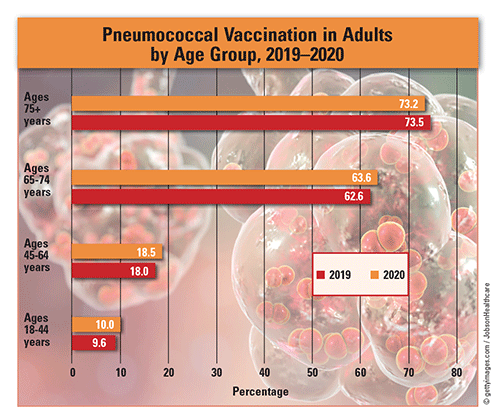US Pharm. 2022;47(7):14.
In 2020, 25.5% of U.S. adults were vaccinated for pneumonia, a 3.3% increase over 2019 (24.7%). Among adults who received pneumococcal vaccination in 2020, 72.5% more were born in the U.S. than in another country, with vaccination rates of 27.6% and 16%, respectively. According to the CDC, more women than men receive pneumococcal vaccination; that said, from 2019 to 2020 men had a disproportionately higher increase (6.6%) in vaccination rate (from 22.6% to 24.1%) compared with women, who had a slight increase of 0.4.% (from 26.6% to 26.7%). In 2020, there was a 10.8% disparity in pneumococcal vaccination between women and men.

Age, Ethnicity, and Marital Status: From 2019 to 2020, the percentage of adults who received pneumococcal vaccination increased sevenfold from the group aged 18 to 44 years to the group aged 75 years and older. However, from 2019 to 2020, the proportion of change in vaccination prevalence was greatest in adults aged 18 to 44 years (4.2%), followed by those aged 45 to 64 years (2.8%). In terms of ethnicity, the rate of pneumococcal vaccination in 2020 was highest among whites (28.3%) and lowest among Asians (17.3%). African Americans had the smallest increase (1.5%) in vaccination from 2019 to 2020 (from 19.6% to 19.9%), and the biggest increase (12%) was among American Indians/Alaska Natives (from 20.9% to 23.4%). In 2020, widowed adults had approximately twice the prevalence of pneumococcal vaccination compared with divorced/separated adults (60.7% vs. 30.1%). The rates were lower in never-married adults (14.5%) and in those living with a partner (15%), whereas 5.5% more married adults (27.1%) were vaccinated in 2020 than in 2019.
Disability: According to the National Health Interview Survey, adults are considered disabled when they have significant difficulty in any one of six functional areas: seeing, hearing, mobility, communication, cognition, and self-care. The rate of pneumococcal vaccination among adults with disabilities (49.4%) was more than double that in adults without disabilities (23.2%). Among adults without disabilities, the rate increased 4% from 2019 to 2020, compared with a 2.7% increase for the same period among those with disabilities.
Employment Status: Of those working full-time, 6.3% more adults received pneumococcal vaccination in 2020 than in 2019 (13.6% vs. 12.8%). There was also an increase among adults who worked part-time (21.5% in 2020 vs. 20.6% in 2019), but the proportion was 31.2% lower than in those working full-time. In adults who were not employed and had never worked, a 18.7% decrease in the rate of pneumococcal vaccination (20.3% in 2019 vs. 16.5% in 2020) was reported.
The content contained in this article is for informational purposes only. The content is not intended to be a substitute for professional advice. Reliance on any information provided in this article is solely at your own risk.
To comment on this article, contact rdavidson@uspharmacist.com.





